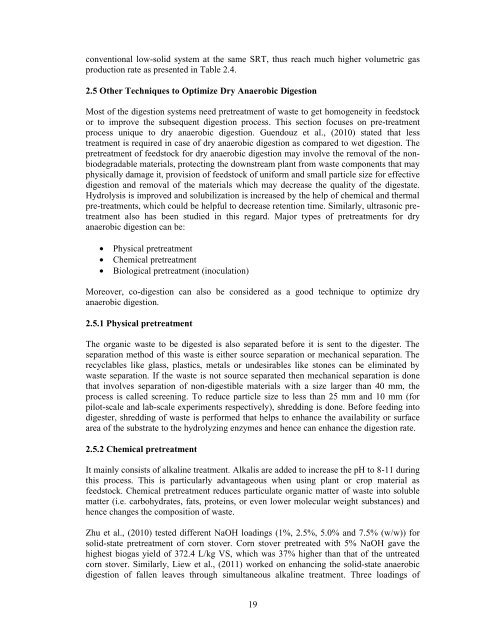dry anaerobic digestion of municipal solid waste and digestate ...
dry anaerobic digestion of municipal solid waste and digestate ...
dry anaerobic digestion of municipal solid waste and digestate ...
Create successful ePaper yourself
Turn your PDF publications into a flip-book with our unique Google optimized e-Paper software.
conventional low-<strong>solid</strong> system at the same SRT, thus reach much higher volumetric gas<br />
production rate as presented in Table 2.4.<br />
2.5 Other Techniques to Optimize Dry Anaerobic Digestion<br />
Most <strong>of</strong> the <strong>digestion</strong> systems need pretreatment <strong>of</strong> <strong>waste</strong> to get homogeneity in feedstock<br />
or to improve the subsequent <strong>digestion</strong> process. This section focuses on pre-treatment<br />
process unique to <strong>dry</strong> <strong>anaerobic</strong> <strong>digestion</strong>. Guendouz et al., (2010) stated that less<br />
treatment is required in case <strong>of</strong> <strong>dry</strong> <strong>anaerobic</strong> <strong>digestion</strong> as compared to wet <strong>digestion</strong>. The<br />
pretreatment <strong>of</strong> feedstock for <strong>dry</strong> <strong>anaerobic</strong> <strong>digestion</strong> may involve the removal <strong>of</strong> the nonbiodegradable<br />
materials, protecting the downstream plant from <strong>waste</strong> components that may<br />
physically damage it, provision <strong>of</strong> feedstock <strong>of</strong> uniform <strong>and</strong> small particle size for effective<br />
<strong>digestion</strong> <strong>and</strong> removal <strong>of</strong> the materials which may decrease the quality <strong>of</strong> the <strong>digestate</strong>.<br />
Hydrolysis is improved <strong>and</strong> solubilization is increased by the help <strong>of</strong> chemical <strong>and</strong> thermal<br />
pre-treatments, which could be helpful to decrease retention time. Similarly, ultrasonic pretreatment<br />
also has been studied in this regard. Major types <strong>of</strong> pretreatments for <strong>dry</strong><br />
<strong>anaerobic</strong> <strong>digestion</strong> can be:<br />
Physical pretreatment<br />
Chemical pretreatment<br />
Biological pretreatment (inoculation)<br />
Moreover, co-<strong>digestion</strong> can also be considered as a good technique to optimize <strong>dry</strong><br />
<strong>anaerobic</strong> <strong>digestion</strong>.<br />
2.5.1 Physical pretreatment<br />
The organic <strong>waste</strong> to be digested is also separated before it is sent to the digester. The<br />
separation method <strong>of</strong> this <strong>waste</strong> is either source separation or mechanical separation. The<br />
recyclables like glass, plastics, metals or undesirables like stones can be eliminated by<br />
<strong>waste</strong> separation. If the <strong>waste</strong> is not source separated then mechanical separation is done<br />
that involves separation <strong>of</strong> non-digestible materials with a size larger than 40 mm, the<br />
process is called screening. To reduce particle size to less than 25 mm <strong>and</strong> 10 mm (for<br />
pilot-scale <strong>and</strong> lab-scale experiments respectively), shredding is done. Before feeding into<br />
digester, shredding <strong>of</strong> <strong>waste</strong> is performed that helps to enhance the availability or surface<br />
area <strong>of</strong> the substrate to the hydrolyzing enzymes <strong>and</strong> hence can enhance the <strong>digestion</strong> rate.<br />
2.5.2 Chemical pretreatment<br />
It mainly consists <strong>of</strong> alkaline treatment. Alkalis are added to increase the pH to 8-11 during<br />
this process. This is particularly advantageous when using plant or crop material as<br />
feedstock. Chemical pretreatment reduces particulate organic matter <strong>of</strong> <strong>waste</strong> into soluble<br />
matter (i.e. carbohydrates, fats, proteins, or even lower molecular weight substances) <strong>and</strong><br />
hence changes the composition <strong>of</strong> <strong>waste</strong>.<br />
Zhu et al., (2010) tested different NaOH loadings (1%, 2.5%, 5.0% <strong>and</strong> 7.5% (w/w)) for<br />
<strong>solid</strong>-state pretreatment <strong>of</strong> corn stover. Corn stover pretreated with 5% NaOH gave the<br />
highest biogas yield <strong>of</strong> 372.4 L/kg VS, which was 37% higher than that <strong>of</strong> the untreated<br />
corn stover. Similarly, Liew et al., (2011) worked on e nhancing the <strong>solid</strong>-state <strong>anaerobic</strong><br />
<strong>digestion</strong> <strong>of</strong> fallen leaves through simultaneous alkaline treatment. Three loadings <strong>of</strong><br />
19

















